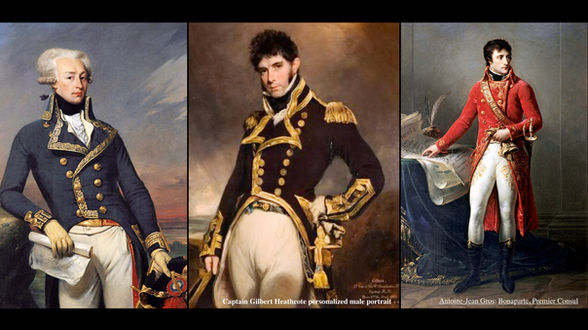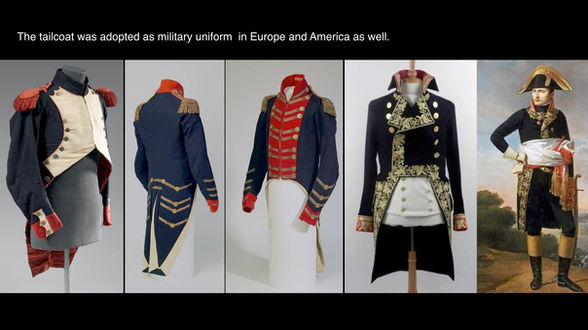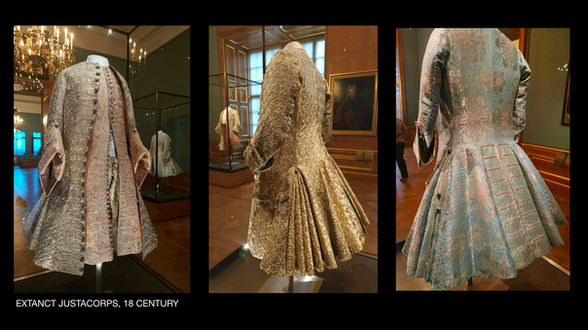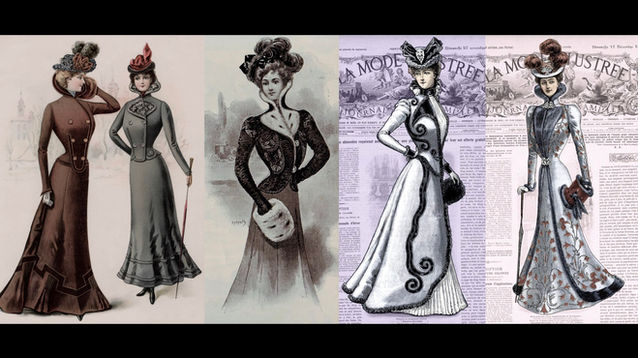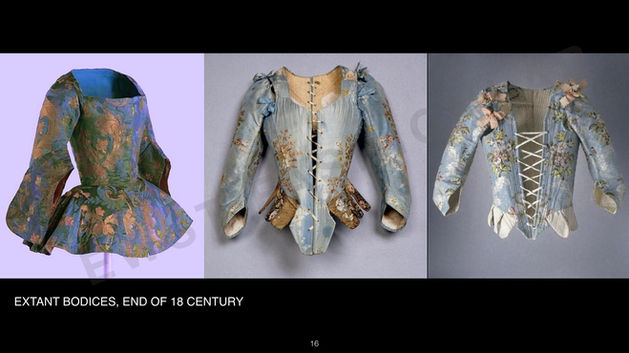Jackets Draping inspired by historical costume
Reflecting on the legacy of dressmaking practices
Courses by level: Basic draping Intermediate draping Advanced draping Complete couture draping
Investigative draping: Balenciaga cocoon dress Balenciaga S-seam coat Yve Saint Laurent Tuxedo jacket
Dior bar jacket Wing pleat hourglass dress Investigative draping full course
Other draping courses: Shawl collar garment Corset draping&design
Inspired by historical costume: Tail coat Riding habit inspired jacket Pierrot jacket inspired Edwardian inspired jacket
Corset jacket draping Sculptured rococo dress
Courses by garment: Skirts draping Dresses draping Jackets draping Collars draping

The scholarship for this course is opened now with more than 60% off!
Draping jackets inspired by historical costume online course scholarship Through this program students will be introduced to the draping mastery as a skillful method of designing jackets and creating patterns directly on the dress form. The particular design of each garment introduced in the course is not a replica of a historical item. Elena's design is unique. In each module Elena showcases specific approaches where design, draping, pattern making and tailoring coming together as one challenge. Her work in general is rather an attempt to replicate, reproduce not the actual garment but the essential approaches to garment fabrication in "old" times and make use of the forgotten practices, giving them a new life; though it is a mix of both - the old and the contemporary ways to garment creation. Application deadline: application opened Scholarship requirements: Dedication to study, commitment to produce the body of work within a given time-frame, and willingness to document and submit all assignments. Upon an enrollment, student is required to submit portfolio (visual materials proving her current design work in progress - photos, images, drawings etc). Intermediate sewing skills are required, pattern making skills are advantageous. The applicant must be able to communicate ( speaking, writing, listening) in English. Application is rather straightforward - fill up and submit the application form, and email the samples of your work/portfolio. Scholarship agreement will be generated and signed by two parties: Scholarship provider - EWST fashionlab represented by its founder, courses creator Elena Ryleeva Scholarship receiver: student name Jackets inspired by historical costume consists of 6 modules and 4 sub-projects: Modules: Tailcoat inspired jacket, Riding habit inspired jacket, Pierrot jacket inspired, Edwardian era inspired jacket, Corset jacket draping, Sculptured rococo dress Sub-projects - Vest with high neck, Cocoon hobble skirt, Pierrot skirt with cartridge pleats, One-piece-pattern dress Each module is equipped with PDF format downloadable guide with detailed and clear instructions that assist you during the studies. Free access to Fashion draping Basics online course is provided Full tutor support and feedback is included (unique opportunity to learn directly from the master). The tutor communicates with each student personally not in group so the privacy of communication is guaranteed. You will receive about 18 hours of recorded video-lessons in total. There are 6 modules in the whole course, some with sub-projects so it comes with 10 assignments. For each one you will receive a feedback| evaluation | advise, anything needed. Duration of scholarship: Draping jackets inspired by historical costume online course - 2 years Scholarship Cost 50% off the initial course price is covered by EWST fashionlab. Course price: 1700 $USD Scholarship 2 years: 620 $USD (savings 1080$) Scholarship admission: Once you are admitted into the scholarship program you will pay the tuition fee in full within 5 days to secure your spot in scholarship program. The access to the course video-lessons will be given to you step by step upon each module completion and assignment submission. Once you send the images of your work to Elena the next module will be opened to you with no interruptions. Upon the course completion the student will be awarded with certificate and attached transcript.
Jackets inspired by historical costume course is explorative as it delves into a different world where the clothes were created by tailors exclusively. In general their names remain unknown but their work speak for itself. The so-called scientific system of pattern-making was not introduced yet as well as in most occasions dress-form and sewing machine. So patterns were created directly on the client and style lines were the product of rather artistic endeavor. Tailors used their patterns library so necessary adjustments were made in accordance with particular client case. Often the jackets styles were originated in military uniforms outlook of which were proposed and regulated. However, tailors work was diverse cleverly combining different approaches in order to achieve the best results.
This course is focused on the tailoring mastery and intuition applied to the natural fabrics and it is observed as major contributor to the art of garment creation.
How the design was created, method:
Observation - close examination of available imagery of garments of 18-19 centuries - internet resources, online costume auctions and museums. Actual museum visits.
Assessing - silhouette creation strategies, fitting lines(seams) aims and functions, grain-line allocation purposes and plans, visual impressions.
Understanding - relations between tailoring and pattern making processes, holistic approach to garment creation; the ergonomics factors of historical clothing construction.
Designing jackets on the dress-form and making patterns through draping using contrived style lines.
The particular design of each garment introduced in the course is not a replica of a historical item. Elena's design is unique. In each module Elena showcases specific approaches where design, draping, pattern making and tailoring coming together as one challenge. Her work in general is rather an attempt to replicate, reproduce not the actual garment but the essential approaches to garment fabrication in "old" times and make use of the forgotten practices, giving them a new life; though it is a mix of both - the old and the contemporary ways to garment creation.
Jackets inspired by historical costume consists of 6 modules and 4 sub-projects:
Modules - Tailcoat inspired jacket, Riding habit inspired jacket, Pierrot jacket inspired, Edwardian era inspired jacket, Corset jacket draping, Sculptured rococo dress
Sub-projects - Vest with high neck, Cocoon hobble skirt, Pierrot skirt with cartridge pleats, One-piece-pattern dress
Importantly, each module is equipped with PDF format downloadable guide with detailed and clear instructions that assist you during the studies.
You may purchase any single unit you like or full course. If you buy a full course or 3 selected units you will get a significant price reduction.
You will have:
18 months access (full course) to the video-lessons
12 months access (3 units)
Around 18 hour of lessons record
Tutor support and feedback
Certification
Full 6 units course fee: 1700 $USD
3 units upon your choice fee: 800 $USD
(course fee is not refundable)
Scholarship for this course is available
The course is addressed to those who are passionate about creative garment construction, appreciate silhouette based clothing and eager to explore the other methods of pattern-making and garment composition.
Tailcoat inspired jacket Riding habit inspired jacket Pierrot jacket inspired Edwardian inspired jacket
Corset jacket draping Sculptured rococo dress
Tail coat inspired jacket designing double collar jacket on a dress-form
Tellingly the tailcoat’s origins lie in the adaptation of the frock. In the late 1700s, the front of the long frock’s skirt (the portion below the waist) was increasingly cut away to make the coat possibly more practical for horseback riding. By the end of the century, all that was left of the skirt was its rear which was divided in half by a long center vent resulting in two “coattails”. This new “tail-coat” was soon adopted as the new dress coat for day and evening.
The course comes with sub-project "Vest draping" and subsequently consists of two parts.
You will have:
6 months access to the video-lessons
Around 4 hour of lessons record
Tutor support and feedback
Certification
Lessons content:
Draping the vest
Starting the project, shaping the waist
Draping the vest' collar
Draping the vest back
Draping the jacket
Draping the front
Draping the jacket second collar
Evaluating and improving the front
Draping the side panel, front
Draping the center back panel
Draping the side panel, back
Assembling front and back pieces
Preparing and draping the sleeve
Final words
Price: 380 $USD



Riding habit inspired jacket designing jacket on a dress-form
From roughly 1790 to 1820, the habit could be a coat dress called a riding coat (borrowed in French as redingote) or a petticoat with a short jacket (often longer in back than in front) The first form of the redingote was in the 18th century. This coat was a bulky, utilitarian garment. Later on it would begin to evolve into a perfectly tailored style of the redingote, which was influenced by men's fashion of the time The men's redingote was an eighteenth-century or early-nineteenth-century long coat or greatcoat, derived from the country garment or "riding coat" with a wide, flat collar called a frock
You will have:
6 months access to the video-lessons
Around 3 hour of lessons record
Tutor support and feedback
Certification
Lessons content:
Project intro, draping the back
Draping the front
Draping the side panel
Assembling the front, the back and the side panel
Evaluating the work, Draping the collar stand
Completing the collar and the lapel
Evaluating the work. Final words
Drafting two-piece sleeve
Creating sleeve "bend", adjusting two-piece sleeve
Price: 350 $USD


Watch extract from the last video-lesson
Pierrot jacket inspired designing jacket on a dress-form
The name 'Pierrot' is originated from the French word for sparrow. The small ruffled tails of this jacket, forward-thrusting bosom and narrow, curved sleeves make references to this bird shape. The fitted Pierrot jacket was popular from the mid-1780s through the 1790s. In this time muslin and linen began to be more commonly worn by the upper classes.
The "Pierrot jacket inspired" presents the version of this jacket with some contemporary adjustments while generating and promoting the "old" types of style-lines which are benefiting the close fit and the aesthetics of the garment in general.
You will have:
6 months access to the video-lessons
Around 3 hour of lessons record
Tutor support and feedback
Certification
Lessons content:
Project intro, style-lines
Draping the center back piece
Draping the second piece of the back
Draping the center front piece
Draping the fourth piece
Draping the collar
Draping the pelerine
Project evaluation
Drafting two-piece sleeve
Creating sleeve "bend", adjusting two-piece sleeve
Price: 350 $USD


Bonus to the Pierrot jacket inspired course: Draping Pierrot skirt, interpretation of cartridge pleats, 20 min video
Exclusive skirt design by Elena Ryleeva
.jpeg)
Edwardian era inspired jacket designing jacket on a dress-form
Edardian era, or La Belle Epoque (beautiful era) - roughly 1890 -1910 clothing. Gone was the bustle and heavy fabrics of the previous century. A new, lighthearted concept overtook women's fashions. Haute couture became truly solidified as a major force in shaping women’s fashion, now synonymous with luxury and artistry.
Early 1890s outfits consisted of a tight bodice/jacket with the skirt falling more naturally over the hips and undergarments than in previous years. From bell-shaped or trumpet-like shape skirts at the beginning of the era the trends gave way to a more relaxed, columnar silhouette and by 1910 introduced a hobble skirt - a tight-fitting skirt that restricted a woman's stride
"Edwardian era inspired jacket" is intended to introduce the art of creating patterns directly on a dress-form following the mastery of 19 century tailors craftsmanship. The course presents the version - an extant garment of Edwardian era that we have discovered online in "Costar project". Elena interprets jacket design with some contemporary adjustments while following the way and approaches of creating and fitting the garment on the dress form.
You will have:
6 months access to the video-lessons
Around 3 hour of lessons record
Tutor support and feedback
Certification
Lessons content:
Project intro, style-lines
Draping the center back panel
Draping the second panel of the back
Draping the side panel
Draping the front panel
Draping the collar
Collar patterns
Verifying the collar. Project evaluation
Drafting two-piece sleeve
Creating sleeve "bend", adjusting two-piece sleeve
Price: 350 $USD

Bonus to the Edwardian era inspired jacket course:
Draping "Cocoon hobble skirt" 20 min video
Exclusive skirt design by Elena Ryleeva

Corset-jacket draping designing jacket on a dress-form
Corset-jacket was inspired and informed by 18 century bodices and corsets.
Bodice refers to a separate upper garment that has removable sleeves or no sleeves, often low-cut, worn in Europe from the 16th century to the 18th century, either over a corset or instead of one. To achieve a fashionable shape and support the bust, the bodice was frequently stiffened with bents (a type of reed) or whalebone. The bodice was separate from the corset of the time because the bodice was intended to be worn over the other garments. The most common type of corset in the 18th century was an inverted conical shape, often worn to create a contrast between a rigid quasi-cylindrical torso above the waist and heavy full skirts below. The primary purpose of 18th-century stays was to shape the torso into a fashionable 'V' or cone shape and creating an upright shoulders-back posture.
You will have:
6 months access to the video-lessons
Around 3 hour of lessons record
Tutor support and feedback
Certification
Lessons content:
Preparations, style-lines
Draping bust details
Second option for bust cup
Draping the center front panel
Draping the front detail with the collar, part 1
Draping the front detail with the collar, part 2
Draping the back side panel
Draping another two panels of the back
Draping back peplum
Project evaluation
Completing the jacket, adding the sleeve
Drafting two-piece sleeve
Creating sleeve "bend", adjusting two-piece sleeve
Price: 350 $USD


Rococo dress draping designing on a dress-form
Rococo dress appeared to be an additional project in the course which was initially focused on the jackets. Since Elena’s corset-jacket design was informed by 18 century garments - bodices and corsets where a part of them was a “stomacher” piece, she used this idea and applied in close fitted sleeveless dress while elaborating it by sculpturing the neckline and upper part of the dress, bearing a resemblance of heavily decorated upper part of Rococo era dresses.
A stomacher is a decorated triangular panel that fills in the front opening of a woman's gown or bodice. The stomacher may be boned, as part of a stays, or may cover the triangular front of a corset. If simply decorative, the stomacher lies over the triangular front panel of the stays, being either stitched or pinned into place, or held in place by the lacing of the gown's bodice.
The course consists of two parts. The first part introduces the draping of one-piece pattern dress - the students learn how to achieve the pattern of a close fitted dress on a mannequin. In the second part the students acquire the knowledge of how to transform the dress into a sculptural object - creating a dress with sculptural properties in its upper part. This undertaking was inspired and informed by garment construction of Rococo (end of 18 century) era and the application of the so-called "stomacher".
You will have:
6 months access to the video-lessons
Around 2 hour of lessons record
Tutor support and feedback
Certification
Lessons content:
One-piece-pattern dress draping
Preparations
Draping the front
Draping the back
Draping the side
Sculptured rococo dress draping
Applying the fabric to transform the dress into sculptural garment
Working on shape
Improving the style, adjusting waist darts
Re-shaping the dress by new darts
Re-assembling the dress
Final version
Price: 305 $USD



